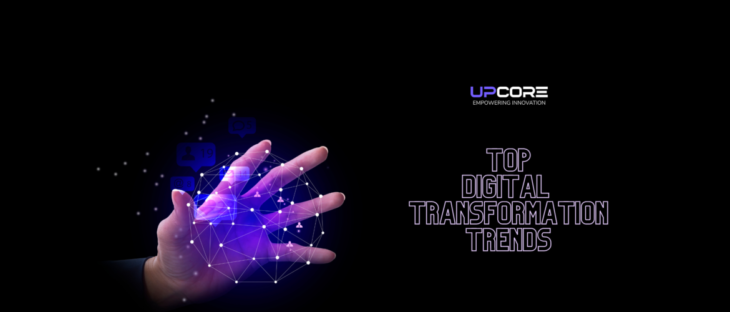
- April 8 2024
- admin
Digital transformation has become an imperative. Emerging technologies, changing customer expectations, and increased competition are forcing companies to adapt quickly.
In this comprehensive guide, we’ll explore the top 20 digital transformation trends that are reshaping business models, operations, and customer experiences across every industry.
The Acceleration of Digital Transformation
The scope and speed of digital change is accelerating dramatically:
- 73% of executives say their digital transformation efforts have accelerated significantly, per McKinsey.
- 55% of companies expect to be fully digital businesses within 5 years, according to Dell Technologies research.
- The global digital transformation market is projected to grow at a CAGR of 22.7% through 2028, reports Fortune Business Insights.
What’s driving this urgency? Primarily, it’s about earning and retaining customers. Gartner found that 81% of company leaders say digital improvements are now required to satisfy customer demands.
Competitors who transform to engage customers digitally tend to win more business. Laggards see revenues decline over time. The pace of change leaves little room for delay.
Let’s examine the top digital transformation trends that are reshaping industries and redefining the future of business.
The Top 20 Digital Transformation Trends
- Emerging technologies – AI, IoT, robotics, VR, and quantum are disrupting operations and enabling new capabilities.
- Hybrid workforce – Remote, automated, and crowd-based work models blend with on-site teams for greater agility.
- Everything-as-a-service – Software, infrastructure, and platforms are consumed as services to gain speed and flexibility.
- Business model pivots – New digital offerings require evolving business models with a recurring revenue focus.
- Customer centricity – Customer experience improvements become centralized through journey analysis, personalization, and automation.
- Growth of mobile – Mobile traffic, sales, and engagement outpace desktop. Optimized experiences are required.
- Seamless omnichannel – Integrated messaging, buying, support, and fulfillment across all customer touchpoints is expected.
- Data-driven decisions – Analytics, big data, and other insights guide strategic business choices using hard metrics.
- Agile processes – Cross-functional agile workflows replace rigid processes to accelerate innovation and change.
- API-led integration – APIs seamlessly connect data, apps, partners, services, and devices in the cloud.
- Internet of Things expansion – Connected smart devices generate data enabling operational efficiencies and insights.
- Multi-cloud adoption – Organizations minimize vendor lock-in using hybrid, multi-cloud infrastructure.
- Expanded automation – Intelligent automation bots and algorithms replace repetitive human work for better efficiency.
- Cybersecurity focus – Data, infrastructure, and application security become embedded everywhere to manage risk.
- Sustainability improvements – Greener operations, supply chains, and products are prioritized as stakeholders demand action.
- Personalization at scale – Individualized experiences are enabled using contextual data and machine learning.
- Video marketing – Video becomes the dominant medium as audiences increasingly consume streaming content.
- Collaboration tools – Remote teams stay connected via platforms like Slack, Asana, and Microsoft Teams.
- Voice user interfaces – Conversational voice UIs through smart speakers and assistants create intuitive engagement.
- Distributed cloud – Workloads and data are distributed to edge networks to reduce latency and enable real-time use cases.
These digital transformation trends reflect how quickly business is evolving. Companies must stay ahead of the curve to remain competitive.
Digital Transformation in Action: Case Studies
Let’s examine real-world examples of leading enterprises embracing digital transformation:
Burberry
- Grew e-commerce sales by 70% after reimagining customer experiences
- Leveraged mobile innovation, omni-retail, and targeted personalization
- Now considered the digital transformation benchmark in luxury retail
By digitally infusing all operations and touchpoints, Burberry accelerated profitable growth even as competitors struggled. Their transformation continues setting the standard.
Lego
- Digitally reinvented business model from legacy toy manufacturer to interactive experience creator
- Launched digital-first products blending physical bricks and virtual worlds
- Created niche social platforms and apps tailored specifically to audiences
Through embracing digital internally and externally, Lego reinvented itself to become more competitive. Digital is now at the core of products, marketing, and monetization.
L’Oréal
- Pioneered makeup virtual try-on augmented reality technology
- Created AI-driven skincare diagnostic apps and services
- Developed intelligent inventory robots automating warehouses
By embracing emerging technologies across functions, L’Oréal builds intimate customer relationships while optimizing operations. Digital makes customization scalable.
PepsiCo
- Connected their entire value chain from field to store for traceability
- Leveraged data and analytics to dynamically match supply and demand
- Improved productivity through digital twin simulations and AI planning
PepsiCo digitized processes end-to-end to increase speed while reducing waste through smarter resource utilization. Now they can tailor offerings to shifting customer needs.
Equinix
- Developed a globally consistent hybrid cloud platform connecting customers to partners
- Enabled secure, high-performance digital infrastructure-as-a-service
- Allowed customers to provision infrastructure on-demand using self-service portals
Equinix transformed its business model to provide digital infrastructure. Their interconnected services power customers’ transformations.
These examples highlight how forward-thinking organizations leverage digital capabilities to gain competitive advantages. Is yours keeping pace?
Expert Perspectives on Accelerating Transformation
Thought leaders provide recommendations to guide executives through digital change:
> “Digital transformation is no longer a choice. Companies must reinvent to create new value in a disruptive environment.” – Amy Webb, Founder of the Future Today Institute
> “Enterprises must become data-driven to accurately assess changing customer behaviors and context. Analytics forms the foundation of digital experience innovation and improvements.” – Lisa Morgan, Technology Journalist for InformationWeek
> “Customer obsession must sit at the heart of digital transformation. As expectations rise, focus like a laser on understanding each customer’s context and desires, then leverage all technologies to serve them.” – Blake Morgan, Customer Experience Futurist and Author
> “Traditional hierarchies slow companies down. To move at the speed of digital, silos must be broken down in favor of agile team collaboration empowered to take risks and learn fast.” – Barry O’Reilly, Business Advisor and Co-Author of Unlearn
> “Weave security into the fabric of digital transformation. Protecting critical data and infrastructure should never be an afterthought.” – Christina Richmond, IDC Program Vice President for Security Services
These experts provide sage advice for avoiding common transformation pitfalls as you leverage emerging digital capabilities. Keep the focus on customers, data, security, collaboration, and agility.
A Roadmap for Navigating Change
Based on the latest digital transformation trends and expert guidance, how should companies adapt? Here is a high-level roadmap:
– Form a steering committee – Appoint business and technology leaders to govern the transformation strategy.
– Audit digital maturity – Assess current digital capabilities against competitors and industry leaders. Identify priority gaps.
– Develop a vision – Create a forward-looking digital vision tied directly to strategic goals.
– Communicate and train – Educate employees on the vision. Encourage ideas around transformation.
– Define KPIs – Determine data-driven KPIs and metrics to track progress toward digital goals.
– Launch pilots – Test emerging technologies and new processes through focused pilot projects first.
– Show quick wins – Focus initial efforts on the biggest challenges and quick wins to build momentum.
– Iterate and scale – Apply lessons learned through agile iterations, then scale what works across the organization.
With the right strategic approach, companies can capitalize on digital transformation trends rather than being disrupted by them. The time to act is now.
The Future is Digital
Digital transformation is no longer a one-time initiative – it’s an ongoing imperative. Competition and customer expectations will continue accelerating.
Organizations must engrain digital philosophies, technologies, and processes into their DNA. Digital transformation will only grow as a strategic priority going forward.
While the scope of change can seem daunting, following a structured approach and keeping the focus on customers positions companies to thrive. By harnessing emerging digital capabilities, leaders can empower teams to innovate smarter and faster.
Does your organization need guidance on its digital transformation journey? The experts at Upcore Technologies specialize in digital strategy and implementation spanning technologies like cloud, AI, automation


